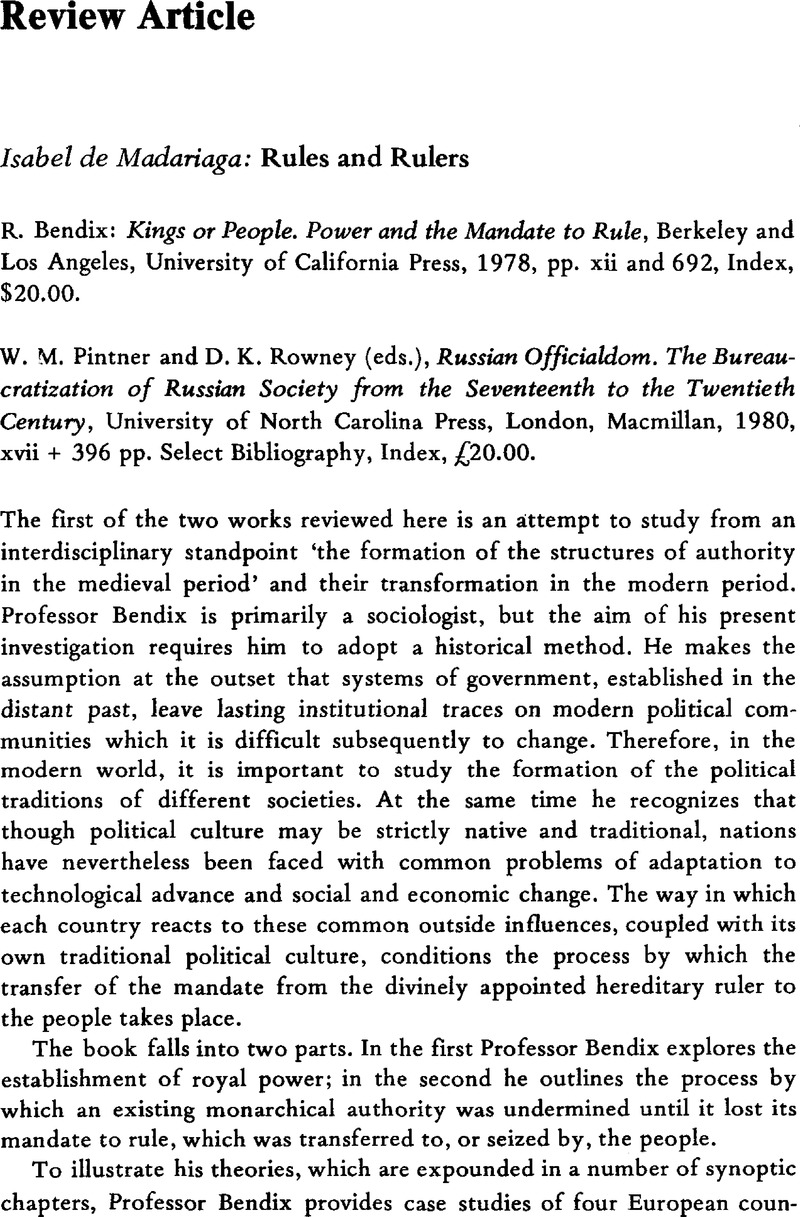No CrossRef data available.
Article contents
Abstract

- Type
- Review Article
- Information
- Copyright
- Copyright © Government and Opposition Ltd 1982
References
1 Weber, M., Wirtschaft und Geselkchaft, 5th edn., ed. by Winckelmann, J., Mohr, J. C. B. (Paul Siebeck) Tübingen, 1972, pp. 580ff.Google Scholar
2 A few examples will suffice: ‘Evidence for mctocracy can be cited from all periods of Chinese history … Nor is there much doubt that Chinese emperors were as autocratic as they could manage to be in practice’ (p. 51); ‘The princely rulers of Russia thus derived their authority directly from God and did not look elsewhere for the mandate to rule. But they and their entourage were Christians who were well aware of the discrepancy between autocratic practice and the Ten Commandments’ (p. 105); ‘Tsarist rule was not sheer autocracy, without consultation or concession’ (p. 170); ‘in Russia the tsar treated the entire realm and its people as his personally owned domain, “autocracy”’ (p. 225). We have here autocratic used as an adjective meaning authoritarian; and as an adjective to describe policies at odds with Christian values; and the noun autocracy is applied to a system of government, to a ‘domain’, or territory. Elsewhere, in the discussion of feudalism, Weber's ‘patrimonial feudalism’ is translated as ‘autocratic feudalism’ which is a contradiction in terms.
3 It would be tedious to list the many errors of fact in the sections dealing with Russia, including the map on p. 109 which includes Kazan as part of Russia in the 15th century, and the map on p. 510 which implies that Kiev was reconquered by Russia in the period 1725–1790. But it should be noted that the Baltic Provinces were ceded to Russia by Sweden by the peace of Nystad in 1721, not bib0 in 1743 (p. 51 1); the statute of education of 1786 did not prescribe the separation ofchildren from their family at an early age (p. 512); and Russian men of letters in the eighteenth century were mainly Russian and noble (p. 504). Other mistakes of fact occur elsewhere, e.g. the Congress of Vienna met first in 1814, not 1815, and it was convened not by Austria, Russia and Prussia but by the four powers, signatories of the treaty of Chaumont, i.e. including Great Britain. The Congress is not to be confused with the Holy Alliance.
4 Szeftel, Marc, ‘The Form of the Russian Government Prior to the Constitutional Reforms of 1905–6’ in Essays in Russian and Soviet History in Honor of G. T. Robinson, ed. Curtiss, J. S., Leiden, , Brill, E. J., 1963.Google Scholar
5 One need only mention the work of S. M. Troitsky, I. V. Orzhekhovsky, P. A. Zaionchkovsky, Leykina Svirskaya in Russia, the comparative studies by J. Armstrong in the West, and the more specialized works by M. Raeff, H.‐J. Torke, G. L. Yaney, D. Field, B. Lincoln, and the authors represented in the present work, notably R. 0. Crummey, B. Meehan Waters, R. D. Givens, B. W. Menning, H. A. Bennett, D. Orlovsky, S. Sternheimer and R. V. Daniels.
6 La Palombara, J., ed. Bureaucracy and Political Development, Princeton University Press, N.J. 1964, p. 51.Google Scholar
7 Raeff, M., ‘The Russian Autocracy and its Officials’ in Russian Thought and Politics, Harvard Slavic Studies IV, 1957;Google Scholar Merle Fainsod, ‘Bureaucracy and Modernization: the Russian and Soviet Case’ in J. La Palombara, op. cit. (badly dated in its historical part); Torke, H.‐J., ‘Das russische Beamtentum in der ersten Halfte des 19. Jahrhunderts’, Forschungen xur Osteuropaischen Geschichte, 13, 1967, pp. 7–345.Google Scholar
8 Translated by M. Metcdf and published by the Gustav and Carin Olin Institutet för Rättshistorisk Forskning.
9 The practice of Kremlinology, i.e. the analysis of the power structure based on placing in non‐alphabetic lists reflects the continuity of the Table of Ranks.




